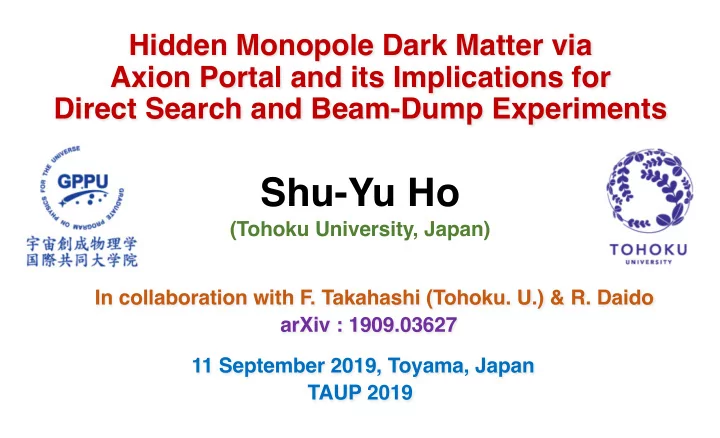

Hidden Monopole Dark Matter via Axion Portal and its Implications for Direct Search and Beam-Dump Experiments Shu-Yu Ho (Tohoku University, Japan) In collaboration with F. Takahashi (Tohoku. U.) & R. Daido arXiv : 1909.03627 11 September 2019, Toyama, Japan TAUP 2019
Hidden monopole dark matter n Hidden monopole is a good dark matter (DM) candidate. 1/15
Hidden monopole dark matter n Hidden monopole is a good dark matter (DM) candidate. n It is an inevitable topological object if the universe experiences n a phase transition in the hidden sector. n Its stability is guaranteed by the topological nature. 1/15
Hidden monopole dark matter n Hidden monopole is a good dark matter (DM) candidate. n It is an inevitable topological object if the universe experiences n a phase transition in the hidden sector. n Its stability is guaranteed by the topological nature. Can we detect the hidden monopole DM? 1/15
Hidden monopole dark matter n Hidden monopole is a good dark matter (DM) candidate. n It is an inevitable topological object if the universe experiences n a phase transition in the hidden sector. n Its stability is guaranteed by the topological nature. Can we detect the hidden monopole DM? n No, at least in the minimum setup. One has to introduce certain couplings with the standard model (SM) sector. 1/15
Hidden monopole DM-SM interactions n There are three possible portals connecting the hidden monopole DM and the SM sector. 2/15
Hidden monopole DM-SM interactions n There are three possible portals connecting the hidden monopole DM and the SM sector. n Higgs portal (expected scattering cross-section is very small ) (c.f. Beak, Ko & Park, 2013) 2/15
Hidden monopole DM-SM interactions n There are three possible portals connecting the hidden monopole DM and the SM sector. n Higgs portal (expected scattering cross-section is very small ) (c.f. Beak, Ko & Park, 2013) n Vector portal (strictly constrained by many exps. and obs. ) (c.f. Jaeckel & Ringwald, 2010) 2/15
Hidden monopole DM-SM interactions n There are three possible portals connecting the hidden monopole DM and the SM sector. n Higgs portal (expected scattering cross-section is very small ) (c.f. Beak, Ko & Park, 2013) n Vector portal (strictly constrained by many exps. and obs. ) (c.f. Jaeckel & Ringwald, 2010) n Axion portal Our main interest (c.f. W. Fischler & J. Preskill '83) 2/15
′ t Hooft-Polyakov monopole n It is known that a magnetic monopole can arise when a n non-abelian gauge symmetry is spontaneously broken n via the Higgs mechanism. ʹt Hooft, Polyakov '74 : products in the group space hidden gauge coupling vev of the scalar field 3/15
′ t Hooft-Polyakov monopole n Expand the Lagrangian density around the vacuum state n Particle spectrum in the hidden sector n Monopole is a static solution with finite energy configuration. 4/15
The Witten effect Witten '79 n The theta term of hidden U(1) gauge symmetry n This term usually has no effect since it is a total derivative. 5/15
The Witten effect Witten '79 n The theta term of hidden U(1) gauge symmetry n This term usually has no effect since it is a total derivative. n However, it has physical effect in the monopole background. ! " Monopole 5/15
The Witten effect Witten '79 n The theta term of hidden U(1) gauge symmetry n This term usually has no effect since it is a total derivative. n However, it has physical effect in the monopole background. # " ! " ! " Dyon Monopole 5/15
Benchmark point n Combined relic abundance of DM Khoze & Ro 2014 ~ 2.2*10^5 GeV ~ ~ 1.5*10^5 GeV ~ ~ 1.0*10^5 GeV ~ 35% hidden monopole DM 6/15
What we did n Axion portal coupling + Yukawa interaction 10 - 1 10 - 2 Yukawa 10 - 3 10 - 4 coupling f a - 1 ( GeV - 1 ) 10 - 5 10 - 6 CHARM 10 - 7 10 - 8 SHiP 10 - 9 Witten effect 10 - 10 10 - 11 10 - 2 10 - 1 10 0 10 1 m a . ( GeV 0 ) Direct detection searches Beam-dump experiments 7/15
Axion portal coupling n Lagrangian density (c.f. W. Fischler & J. Preskill 83') n Equation of motion of the axion field n Boundary conditions : The total energy density of the axion-monopole system must be finite. 8/15
Axion profile around the monopole 9/15
Hidden monopole-nucleon scattering n Axion-nucleon interaction (Yukawa coupling) n Amplitude of the hidden monopole-nucleon scattering Axion profile n Spin-dependent cross-section 10/15
$% Direct search exps. : ! " vs # " 11/15
Beam-dump experiments n Experimental setup (CHARM) *, , ± , . ± , * / , … ) Target Detector decay Proton beam beam-dump ! = 35 & ! = 480 & J.D. Clarke et al. 2014 12/15
$% Beam-dump exps. : ! " vs # " 13/15
$% Combined result : ! " vs # " We find two parameter regions where both the hidden monopole DM and the axion are within the reach of the direct search and beam-dump experiments. 14/15
Summary n We have studied the hidden monopole DM via the axion portal. n We have computed the spin-dependent cross-section of the hidden monopole DM scattering off a nucleon and compare it n to the direct search experiments. n We have found two parameter n regions where both the hidden n monopole DM and the axion n are within the reach of the n direct search experiments n & beam-dump experiments. 15/15
Back up
Kibble-Zurek mechanism n Second-order phase transition Correlation length Relaxation time Frozen :
Benchmark point n Self-interacting DM : Hidden monopole Khoze & Ro 2014 Green region 35% hidden monopole DM
Recommend
More recommend